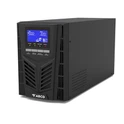
The reason why double conversion uninterruptible power supply systems are called double conversion UPS is that they use AC power to convert them into DC and then back to AC power. This "double conversion" is of course the lowest efficiency of all UPS technologies, but it has obvious advantages, that is, during the transition from AC power supply to battery operation, it can produce a high stable and high-quality power output without interruption.

A common misconception is that the AC to DC conversion is assumed to be battery powered, and then the battery provides DC to convert to AC. What actually happens is that the input AC input supplies power to both circuits. One is the battery charger, which rectifies the input AC and provides a floating voltage for the battery to charge or keep charging. The second is the AC boost circuit, which converts the input AC into DC "bus". The bus is supported by high value capacitors, which maintain the level during conversion.
Dual conversion UPS process
In case of power failure, the device switches the bus power from the AC boost circuit to the DC boost circuit. This circuit is a DC-DC converter, which obtains DC voltage from the battery and converts it into bus voltage. The bus capacitor ensures a seamless transition to the inverter. Inverter is a circuit that converts DC input to AC output. There are two ways to do this. One is called "low frequency" and the other is called "high frequency". Low frequency units use simple switching inverters and require transformers. The high frequency unit uses a special technology called pulse width modulation (PWM) to quickly switch the bus to generate a pulse train output, and then filters the pulse train output to generate a sine wave output.

Online double conversion uninterruptible power supply is considered to provide the best power protection because they can overcome power problems that cannot be solved by other technologies. They are also recommended technologies for extended operation of UPS systems, because they generate sine wave sockets, and because the inverter is designed for all-weather operation, it has higher reliability. Since the inverter is always on, forced air cooling is adopted. Although many systems use fan speed control, noise can be distracting based on load levels and should be considered when using dual conversion technology in quiet office or residential environments.






